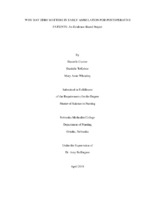Why day zero matters in early ambulation for postoperative patients: An evidence-based project
View File(s)
- Author(s)
- Details
-
Danielle TeKolste BSN, RN; Danielle Currier BSN, RN; Mary Anne Wheatley BSN, RN
- Sigma Affiliation
- Non-member
Visitor Statistics
Visits vs Downloads
Visitors - World Map
Top Visiting Countries
| Country | Visits |
|---|
Top Visiting Cities
| City | Visits |
|---|
Visits (last 6 months)
Downloads (last 6 months)
Popular Works for TeKolste, Danielle by View
| Title | Page Views |
|---|
Popular Works for TeKolste, Danielle by Download
| Title | Downloads |
|---|
View Citations
Citations
The purpose of this evidence-based practice project is to review the literature to determine if ambulation on postoperative day zero improved patient outcomes when compared to ambulation on postoperative day one. The PICOT question used in this research project was: In adult patients in a postoperative setting, how does ambulation within twelve hours of surgery compare to non-early ambulation after twelve hours of surgery improve patient outcomes during the first thirty days following surgery? This topic addressed both quality improvement and evidence based practice in nursing. The evidence revealed how the timing of ambulation after surgery has the ability to improve patient outcomes. Early ambulation had a positive impact on physical, psychological, and social outcomes and decreased complications. A search of the Cochrane, PubMed, and Cinahl plus Full Text databases was conducted and three articles assumed the criteria. Two literature reviews and one randomized controlled trial were analyzed. Future recommendations for nursing include: further research in timing of ambulation, staff education, compliance, and administrative awareness and support. A change in policy is needed when ambulation within twelve hours after surgery is not the standard of care for postoperative patients.
This work has been approved through a peer-review process prior to its posting in the Virginia Henderson Global Nursing e-Repository.
Clinical Focus: Adult Medical/Surgical
| Type | Thesis |
| Acquisition | Self-submission |
| Review Type | Peer-review: Single Blind |
| Format | Text-based Document |
| Evidence Level | Literature Review |
| Research Approach | Translational Research/Evidence-based Practice |
| Keywords | Postoperative Complications; Ambulation; Postoperative Ambulation; Postoperative Day Zero; Inpatients; Mobilization; Patient Outcomes; Postoperative Patient |
| CINAHL Subject(s) | Early Ambulation; Postoperative Care--Methods; Outcomes (Health Care); Treatment Outcomes; Perioperative Nursing; Inpatients; Physical Mobility |
| Grantor | Nebraska Methodist College |
| Advisor | Bullington, Amy |
| Level | Master's |
| Year | 2018 |
All rights reserved by the author(s) and/or publisher(s) listed in this item record unless relinquished in whole or part by a rights notation or a Creative Commons License present in this item record.
All permission requests should be directed accordingly and not to the Sigma Repository.
All submitting authors or publishers have affirmed that when using material in their work where they do not own copyright, they have obtained permission of the copyright holder prior to submission and the rights holder has been acknowledged as necessary.
Related items
Showing items related by title, author, creator and subjects.
-
Effects of perioperative Midazolam administration on postoperative nausea and vomiting in patients undergoing general anesthesia: An evidence-based practice analysis
McMillin, Haley R.Patients undergoing general anesthesia are at risk of developing postoperative nausea and vomiting (PONV) with reported incidences ranging from 30% to as high as 80% in high-risk populations. The fear of experiencing nausea ... -
In the acute care setting what is the effect of bedside nursing report on patient safety when compared with traditional reporting methods: An evidence-based project
Rolling, Heather; Pauley, Jessica; Hoyt, Jaclyn (7/24/2015)The purpose of this evidence-based project was to examine the effect of bedside report on patient outcomes and nurse/patient satisfaction. Many key components to the report could be affected if report is done through ... -
Using pause and flow (physics) as a method to improve the experience for staff and patients
Hozak, Mary Ann; Bywater, Janina Sweetenham; Nelson, John W. (2016-03-17)Session presented on Sunday, July 26, 2015: Constructal Law has been used in multiple sciences to illustrate how design can impede or enhance flow. This session will reveal how Constructal Law, physics, was used to study ... -
An evidence-based practice project to improve securement and visualization of peripheral intravenous catheters in pediatric patients
Smith, Andrea; Isaacson, Jill; Campbell, Leigh Anne; Hill, Robert Elkin; Martin, Shirley D.; Badgett, Valerie J.; Frey, Suzanne M.; Davis, Melodie; Pearcy, Terri; Kuchta, Mollie D. (2012-01-04)Problem: Securement and visualization of peripheral intravenous catheter sites (PIV) is a common problem for pediatric nurses worldwide because infiltration of IV fluid can lead to serious complications. Quality data, staff ... -
Evaluation of the implementation of ASPAN's evidence-based clinical practice guideline for the prevention and/or treatment of postoperative nausea and vomiting
Stephens, Lisa (2016-03-17)Session presented on Friday, July 24, 2015: Evaluation of the Implementation of the ASPAN's Evidence-Based Clinical Practice Guideline for the Prevention and/or Treatment of Postoperative Nausea and Vomiting Lisa Stephens ...





